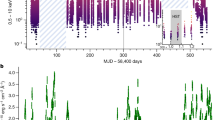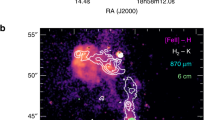Abstract
Collimated relativistic outflows—also known as jets—are amongst the most energetic phenomena in the Universe. They are associated with supermassive black holes in distant active galactic nuclei1, accreting stellar-mass black holes and neutron stars in binary systems2 and are believed to be responsible for γ-ray bursts3. The physics of these jets, however, remains something of a mystery in that their bulk velocities, compositions and energetics remain poorly determined. Here we report the discovery of an ultra-relativistic outflow from a neutron star accreting gas within a binary stellar system. The velocity of the outflow is comparable to the fastest-moving flows observed from active galactic nuclei, and its strength is modulated by the rate of accretion of material onto the neutron star. Shocks are energized further downstream in the flow, which are themselves moving at mildly relativistic bulk velocities and are the sites of the observed synchrotron emission from the jet. We conclude that the generation of highly relativistic outflows does not require properties that are unique to black holes, such as an event horizon.
This is a preview of subscription content, access via your institution
Access options
Subscribe to this journal
Receive 51 print issues and online access
$199.00 per year
only $3.90 per issue
Buy this article
- Purchase on Springer Link
- Instant access to full article PDF
Prices may be subject to local taxes which are calculated during checkout


Similar content being viewed by others
References
Ostrowski, M., Sikora, M., Madejski, G. & Begelman, M. (eds) Relativistic Jets in AGNs (Towarzystwa Salezjańskiego, Krakow, 1997)
Mirabel, I. F. & Rodriguez, L. F. Sources of relativistic jets in the Galaxy. Annu. Rev. Astron. Astrophys. 37, 409–443 (1999)
Sari, R., Piran, T. & Halpern, J. P. Jets in gamma-ray bursts. Astrophys. J. 519, L17–L20 (1999)
Kaluzienski, L. J., Holt, S. S., Voldt, E. A. & Serlemitsos, P. J. Evidence for a 16.6 day period from Circinus X-1. Astrophys. J. 208, L71–L75 (1976)
Johnston, H. M., Fender, R. & Wu, K. High-resolution optical and infrared spectroscopic observations of CIR X-1. Mon. Not. R. Astron. Soc. 308, 415–423 (1999)
Tennant, A. F., Fabian, A. C. & Shafer, R. A. Observation of type I X-ray bursts from CIR X-1. Mon. Not. R. Astron. Soc. 221, P27–P31 (1986)
Haynes, R. F. et al. Simultaneous radio and optical observations of CIR X-1. Mon. Not. R. Astron. Soc. 185, 661–671 (1978)
Fender, R. P. & Kuulkers, E. On the peak radio and X-ray emission from neutron star and black hole candidate X-ray transients. Mon. Not. R. Astron. Soc. 324, 923–930 (2001)
Haynes, R. F. et al. A radio nebula associated with Circinus X-1. Nature 324, 233–235 (1986)
Stewart, R. T., Caswell, J. L., Haynes, R. F. & Nelson, G. J. Circinus X-1—A runaway binary with curved radio jets. Mon. Not. R. Astron. Soc. 261, 593–598 (1993)
Fender, R. P. et al. An asymmetric arcsecond radio jet from Circinus X-1. Astrophys. J. 506, L121–L125 (1998)
Fomalont, E. B., Geldzahler, B. J. & Bradshaw, C. F. Scorpius X-1: Energy transfer from the core to the radio lobes. Astrophys. J. 553, L27–L30 (2001)
Fomalont, E. B., Geldzahler, B. J. & Bradshaw, C. F. Scorpius X-1: The Evolution and nature of the twin compact radio lobes. Astrophys. J. 558, 283–301 (2001)
Kaiser, C. R., Sunyaev, R. & Spruit, H. C. Internal shock model for microsquasars. Astron. Astrophys. 356, 975–988 (2000)
Corbel, S. et al. Large-scale, decelerating, relativistic X-ray jets from the microquasar XTE J1550-564. Science 298, 196–199 (2002)
Krolik, J. H. Active Galactic Nuclei (Princeton Series in Astrophysics, Princeton Univ. Press, Princeton, USA, 1999)
Saikia, D. J. & Salter, C. J. Polarization properties of extragalactic radio sources. Annu. Rev. Astron. Astrophys. 26, 93–144 (1988)
Shirey, R. E., Bradt, H. V. & Levine, A. M. The complete “Z” track of Circinus X-1. Astrophys. J. 517, 472–487 (1999)
Livio, M. Astrophysical jets: a phenomenological examination of acceleration and collimation. Phys. Rep. 311, 225–245 (1999)
Fender, R. P. Uses and limitations of relativistic jet proper motions: Lessons from galactic microquasars. Mon. Not. R. Astron. Soc. 340, 1353–1358 (2003)
Ghisellini, G., Padovani, P., Celotti, A. & Maraschi, L. Relativistic bulk motion in active galactic nuclei. Astrophys. J. 407, 65–82 (1993)
Jorstad, S. G. et al. Multiepoch Very Long Baseline Array observations of EGRET-detected quasars and BL Lacertae objects: Superluminal motion of gamma-ray bright blazars. Astrophys. J. Supp. Ser. 134, 181–240 (2001)
Acknowledgements
The Australia Telescope is funded by the Commonwealth of Australia for operation as a national facility managed by CSIRO.
Author information
Authors and Affiliations
Corresponding author
Ethics declarations
Competing interests
The authors declare that they have no competing financial interests.
Rights and permissions
About this article
Cite this article
Fender, R., Wu, K., Johnston, H. et al. An ultra-relativistic outflow from a neutron star accreting gas from a companion. Nature 427, 222–224 (2004). https://doi.org/10.1038/nature02137
Received:
Accepted:
Issue Date:
DOI: https://doi.org/10.1038/nature02137
This article is cited by
-
How to distinguish an actual astrophysical magnetized black hole mimicker from a true (theoretical) black hole
Astrophysics and Space Science (2021)
-
Kilonovae
Living Reviews in Relativity (2017)
-
Accretion, Outflows, and Winds of Magnetized Stars
Space Science Reviews (2015)
-
Scaling Relations from Stellar to Supermassive Black Holes
Space Science Reviews (2014)
-
Black hole binaries and microquasars
Frontiers of Physics (2013)
Comments
By submitting a comment you agree to abide by our Terms and Community Guidelines. If you find something abusive or that does not comply with our terms or guidelines please flag it as inappropriate.



